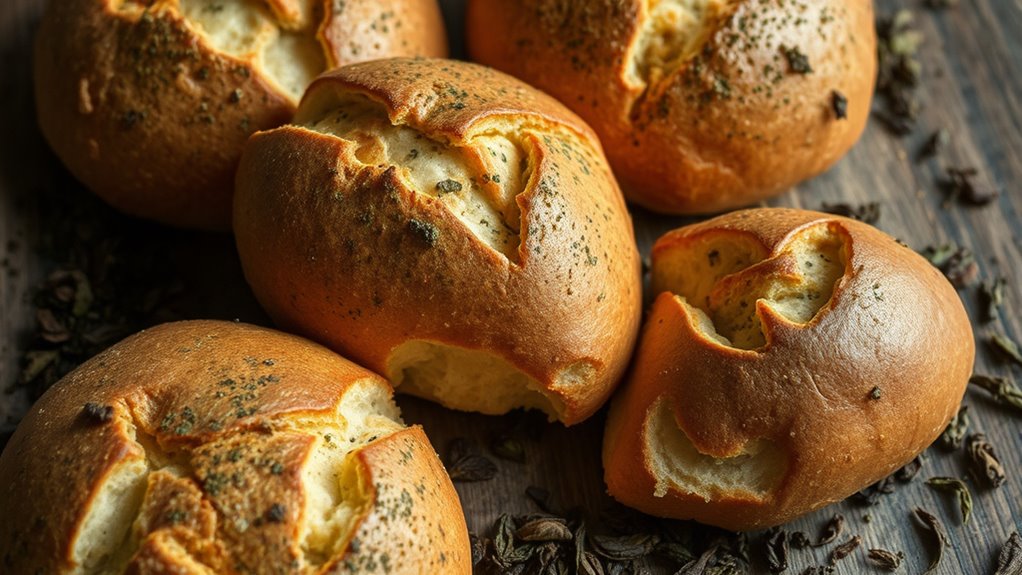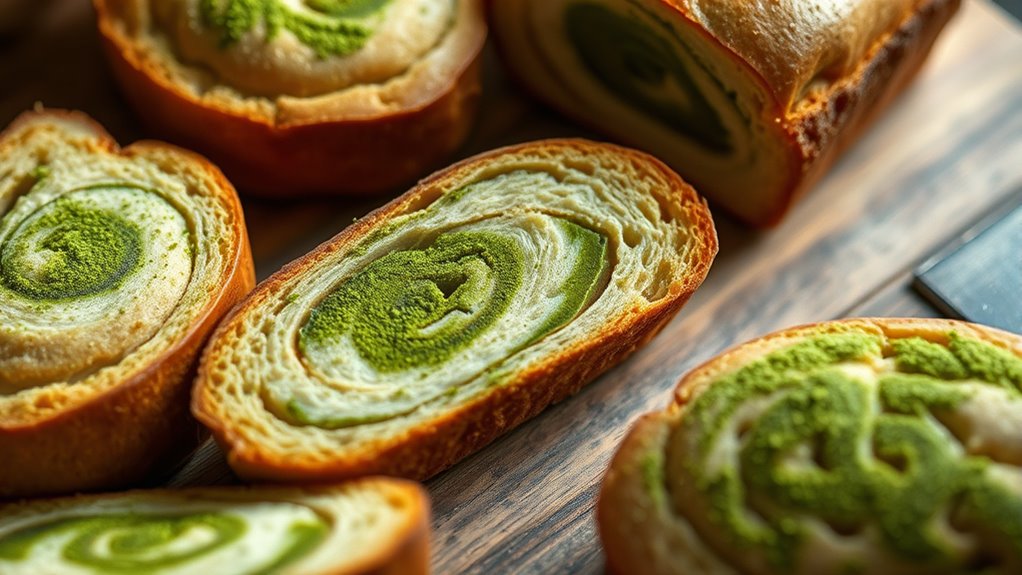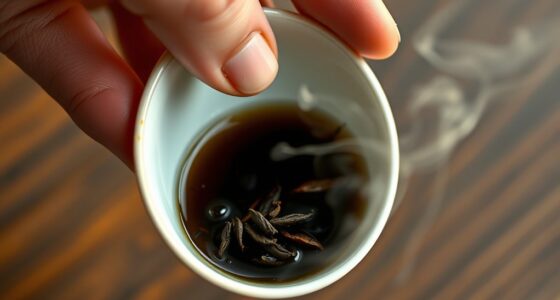Tea-infused breads are becoming a popular culinary trend as you experiment with combining the rich flavors of different teas into your baked goods. By brewing strong tea concentrates and replacing part of the liquid in your recipes, you can create unique and aromatic loaves. Different teas like matcha, black, or white add distinct notes, elevating your baking skills. Keep exploring how to perfect your infusion techniques, and you’ll uncover even more flavorful possibilities.
Key Takeaways
- Tea-infused breads incorporate brewed teas into dough for unique flavor profiles and aromatic complexity.
- Different teas (green, black, matcha) offer diverse tastes, from grassy to earthy to floral notes.
- Proper brewing techniques ensure optimal infusion without compromising bread texture or moisture balance.
- This trend combines traditional baking with innovative flavor experiments, appealing to gourmet and health-conscious consumers.
- Creative use of tea elevates bread varieties, making them a sophisticated and versatile addition to modern baking.

Tea-infused breads are a delightful way to add a subtle, aromatic flavor to your baking. When you incorporate tea into your bread recipes, you’re opening up a world of complex tea flavor profiles that can elevate your baked goods from ordinary to extraordinary. Different teas bring unique notes—green teas add a grassy freshness, black teas lend a robust, malty richness, and white teas offer delicate, floral hints. To achieve the best flavor infusion, understanding brewing techniques becomes essential. Properly brewing your tea guarantees you extract the optimal flavors without overpowering the bread or introducing excess moisture. Usually, a strong tea concentrate works best; steep your tea leaves longer than usual, but avoid oversteeping to prevent bitterness. Using cooled, concentrated tea in your dough provides a more intense flavor while maintaining the right texture.
Enhance your bread with concentrated, properly brewed tea for rich, subtle flavor and perfect texture.
When you plan your tea-infused bread, pay attention to how the brewing process influences the final taste. For example, a strong matcha brewed into a vivid, vibrant green can introduce an earthy, slightly bitter note, balancing well with sweet or savory ingredients. Conversely, a gentle white tea infusion offers a subtle, nuanced aroma that complements light, buttery bread. Experiment with steeping times, water temperatures, and leaf-to-water ratios to tailor the tea flavor profiles to your liking. Remember, the goal is to extract enough flavor without making the tea overpowering or adding too much liquid, which could affect your dough’s consistency. Incorporating vetted tea brands can help ensure the quality and purity of your infusion.
Incorporating brewed tea into your bread dough is straightforward. Replace a portion of the liquid in your recipe with your brewed tea, adjusting the amount to suit your flavor preference and moisture content. You can also infuse butter or milk with tea before adding it to the dough, creating an even more layered flavor experience. As you bake, the heat transforms the tea’s aromatic qualities, releasing subtle nuances that fill your kitchen with inviting scents. The result is a bread that not only tastes delicious but also offers a sophisticated twist on traditional baking.
Ultimately, mastering brewing techniques is key to unleashing the full potential of tea flavor profiles in your breads. By experimenting with different teas and steeping methods, you can craft unique, aromatic loaves that appeal to both your palate and guests. This emerging culinary trend invites you to explore the harmonious blend of tea’s complexity with the comforting warmth of freshly baked bread, making your baking sessions more creative and flavorful.
Frequently Asked Questions
How Do Different Tea Types Affect Bread Flavor Profiles?
When exploring how different tea types affect bread flavor profiles, you’ll notice that each offers unique tea pairing possibilities for flavor enhancement. Black teas add a bold, malty taste, while green teas provide a fresh, grassy note. Oolong and white teas bring subtle, nuanced flavors. You can experiment with these to complement or contrast your bread ingredients, creating a deliciously layered experience that’s both aromatic and flavorful.
What Are the Best Tea-To-Flour Ratios for Optimal Infusion?
Imagine discovering the perfect balance in your recipe—start with a tea-to-flour ratio of about 1-2 teaspoons of tea leaves per cup of flour. Adjust based on your desired tea concentration, ensuring it’s not overpowering. Infusion duration matters too; steep the tea for 10-15 minutes. This way, you’ll achieve an ideal infusion that enhances your bread’s flavor without overwhelming it, making every bite memorable.
Can Tea-Infused Bread Be Stored Without Losing Flavor?
You wonder if tea-infused bread can be stored without losing flavor. To maintain storage stability and flavor preservation, wrap the bread tightly in plastic or foil and keep it in an airtight container. Store it at room temperature for up to two days or refrigerate for longer freshness. Avoid exposure to air and moisture, which can diminish the tea flavor over time. Proper storage helps retain the delightful infusion in your bread.
Are There Health Benefits Associated With Tea-Infused Breads?
You might think tea-infused breads are just delicious, but they pack a punch with antioxidant benefits that could boost your health. Plus, the caffeine content might give you an energizing kick, rivaling your morning coffee! These breads could help fight free radicals and improve focus. So, indulging in them isn’t just tasty—you’re potentially reaping some health perks too, making every bite a small victory for your well-being.
How Does Tea Infusion Impact the Bread’S Baking Time and Texture?
When you add tea infusion to your dough, it can slightly alter the baking time and texture. The tea adds moisture, affecting dough hydration, which may require adjusting your oven temperature or baking duration. You might find that bread with tea infusions bakes a bit faster or develops a more tender crumb. Keep an eye on the crust and internal temperature to guarantee perfect results, adjusting as needed for ideal texture.
Conclusion
As you explore tea-infused breads, you’re gently guided into a world where tradition whispers softly alongside innovation. Each bite offers a subtle dance of flavors, inviting you to savor moments of calm and curiosity. Embrace this trend as a quiet invitation to elevate your baking journey, blending comfort with a hint of adventure. In the end, it’s about discovering new tastes that softly inspire and warmly linger, enriching your culinary story with every loaf.










